Reconstruction of Process Forces in a Five-Axis Milling Center with a LSTM Neural Network in Comparison to a Model-Based Approach
Abstract
1. Introduction
2. Materials and Methods
2.1. Experimental Setup
2.2. Model-Based Force Reconstruction
2.3. Neural Network Based Force Reconstruction
3. Results
3.1. Model-Based Force Reconstruction
3.2. LSTM
4. Conclusions and Outlook
Author Contributions
Funding
Acknowledgments
Conflicts of Interest
References
- Altintas, Y. Prediction of Cutting Forces and Tool Breakage in Milling from Feed Drive Current Measurements. J. Eng. Ind. 1992, 114, 386–392. [Google Scholar] [CrossRef]
- Plapper, V.; Weck, M. Sensorless machine tool condition monitoring based on open NCs. In Proceedings of the 2001 ICRA IEEE International Conference on Robotics and Automation (Cat. No.01CH37164), Seoul, Korea, 21–26 May 2001; Volume 3, pp. 3104–3108. [Google Scholar]
- Cus, F.; Zuperl, U. Model reference-based machining force and surface roughness control. J. Achiev. Mater. Manuf. Eng. 2008, 29, 115–122. [Google Scholar]
- Dow, T.A.; Miller, E.L.; Garrard, K. Tool force and deflection compensation for small milling tools. Precis. Eng. 2004, 28, 31–45. [Google Scholar] [CrossRef]
- Denkena, B.; Dahlmann, D.; Boujnah, H. Tool Deflection Control by a Sensory Spindle Slide for Milling Machine Tools. Procedia CIRP 2017, 62, 329–334. [Google Scholar] [CrossRef]
- Miura, K.; Döbbeler, B.; Klocke, F. Cutting power estimation via external voltage and current sensors on feed-drive axis for the straight milling process. Procedia CIRP 2018, 78, 323–328. [Google Scholar] [CrossRef]
- Schwenzer, M.; Auerbach, T.; Miura, K.; Döbbeler, B.; Bergs, T. Support vector regression to correct motor current of machine tool drives. J. Intell. Manuf. 2020, 31, 553–560. [Google Scholar] [CrossRef]
- Yamada, Y.; Kakinuma, Y. Sensorless cutting force estimation for full-closed controlled ball-screw-driven stage. Int. J. Adv. Manuf. Technol. 2016, 87, 3337–3348. [Google Scholar] [CrossRef]
- Yamada, Y.; Yamato, S.; Kakinuma, Y. Mode decoupled and sensorless cutting force monitoring based on multi-encoder. Int J. Adv. Manuf. Technol. 2017, 92, 4081–4093. [Google Scholar] [CrossRef]
- Aslan, D.; Altintas, Y. Prediction of Cutting Forces in Five-Axis Milling Using Feed Drive Current Measurements. IEEE/ASME Trans. Mechatron. 2018, 23, 833–844. [Google Scholar] [CrossRef]
- Jeong, Y.-H.; Cho, D.-W. Estimating cutting force from rotating and stationary feed motor currents on a milling machine. Int. J. Mach. Tools Manuf. 2002, 42, 1559–1566. [Google Scholar] [CrossRef]
- Kim, T.-Y.; Woo, J.; Shin, D.; Kim, J. Indirect cutting force measurementnin multi-axis simultaneous NC milling process. Int. J. Mach. Tools Manuf. 1999, 39, 1717–1731. [Google Scholar] [CrossRef]
- Königs, M.; Wellmann, F.; Wiesch, M.; Epple, A.; Brecher, C.; Schmitt, R.; Schuh, G. A scalable, hybrid learning approach to process-parallel estimation of cutting forces in milling applications. Robert Schmitt Günther Schuh (Publ.) 2017, 7, 425–432. [Google Scholar]
- Zagórski, I.; Kulisz, M.; Semeniuk, A. Artificial Neural Network Modelling of Cutting Force Components in Milling; EDP Sciences: Les Ulis, France, 2017; Volume 15, p. 02001. [Google Scholar]
- Zuperl, U. Cus, Franc Adaptive Network Based Inference System for Cutting Force Simulation in Milling of Multi-Layered Metal Materials. Proc. Manuf. Syst. 2017, 12, 47–52. [Google Scholar]
- Matlab. Available online: https://www.mathworks.com/products/matlab.html (accessed on 1 July 2020).
- Albrecht, A. Wärmedehnungskompensierte Rekonstruktion von Prozesskräften an Vorschubantrieben. Ph.D. Thesis, Technische Universität Braunschweig, Braunschweig, Germany, 2009. [Google Scholar]
- Ruderman, M. Zur Modellierung und Kompensation dynamischer Reibung in Aktuatorsystemen. Ph.D. Thesis, Technische Universität Dortmund, Dortmund, Germany, 2012. [Google Scholar]
- Hochreiter, S.; Schmidhuber, J. Long Short-Term Memory. Neural Comput. 1997, 9, 1735–1780. [Google Scholar] [CrossRef] [PubMed]
- Greff, K.; Srivastava, R.K.; Koutnik, J.; Steunebrink, B.R.; Schmidhuber, J. LSTM: A Search Space Odyssey. IEEE Trans. Neural Netw. Learn. Syst. 2017, 28, 2222–2232. [Google Scholar] [CrossRef] [PubMed]
- Lipton, Z.C.; Kale, D.C.; Elkan, C.; Wetzel, R. Learning to Diagnose with LSTM Recurrent Neural Networks. arXiv 2017, arXiv:1511.03677. [Google Scholar]
- Gers, F.A.; Schmidhuber, J. Recurrent nets that time and count. In Proceedings of the IEEE-INNS-ENNS International Joint Conference on Neural Networks. IJCNN 2000. Neural Computing: New Challenges and Perspectives for the New Millennium, Como, Italy, 27 July 2000; Volume 3, pp. 189–194. [Google Scholar]
- Srivastava, N.; Hinton, G.; Krizhevsky, A.; Sutskever, I.; Salakhutdinov, R. Dropout: A simple way to prevent neural networks from overfitting. J. Mach. Learn. Res. 2014, 15, 1929–1958. [Google Scholar]
- Zhu, X.; Vondrick, C.; Ramanan, D.; Fowlkes, C.C. Do We Need More Training Data or Better Models for Object Detection; Citeseer: University Park, PA, USA, 2012; Volume 3. [Google Scholar]
- Kienzle, O. Die bestimmung von kräften und Leistungen an spanenden Werkzeugen und Werkzeugmaschinen. VDI-Z 1952, 94, 299–305. [Google Scholar]

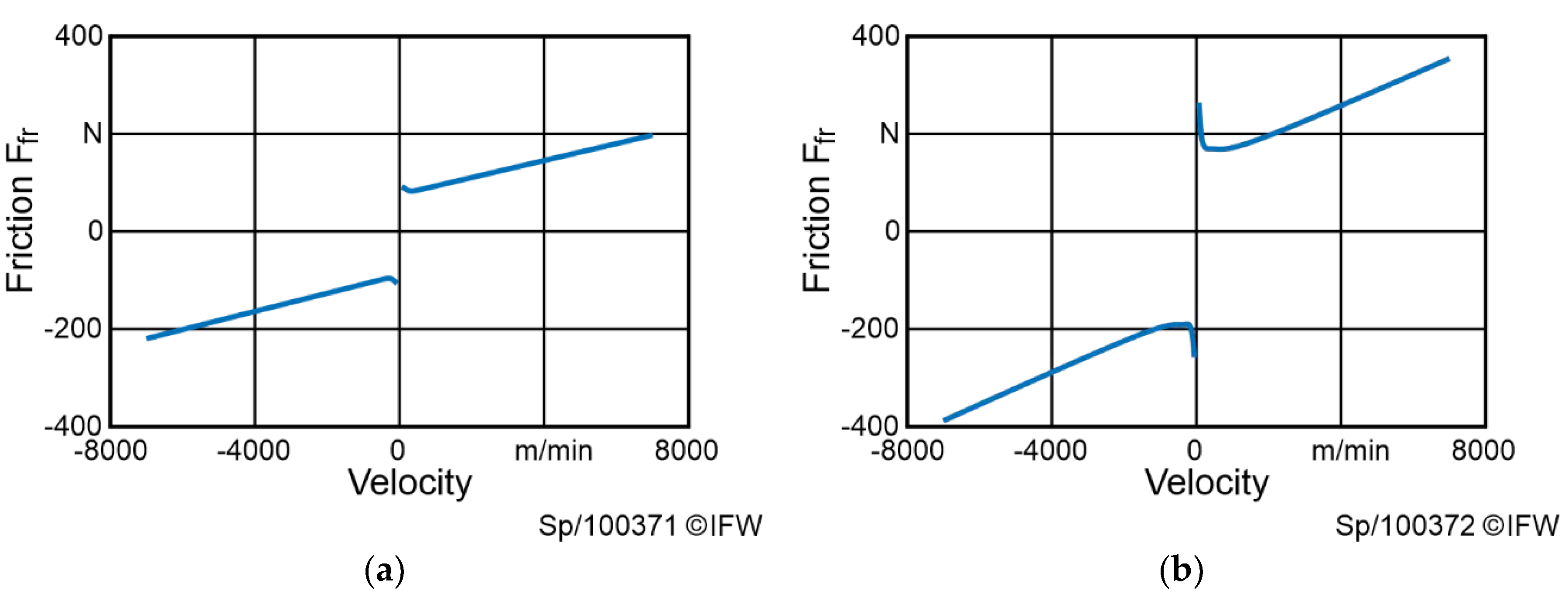
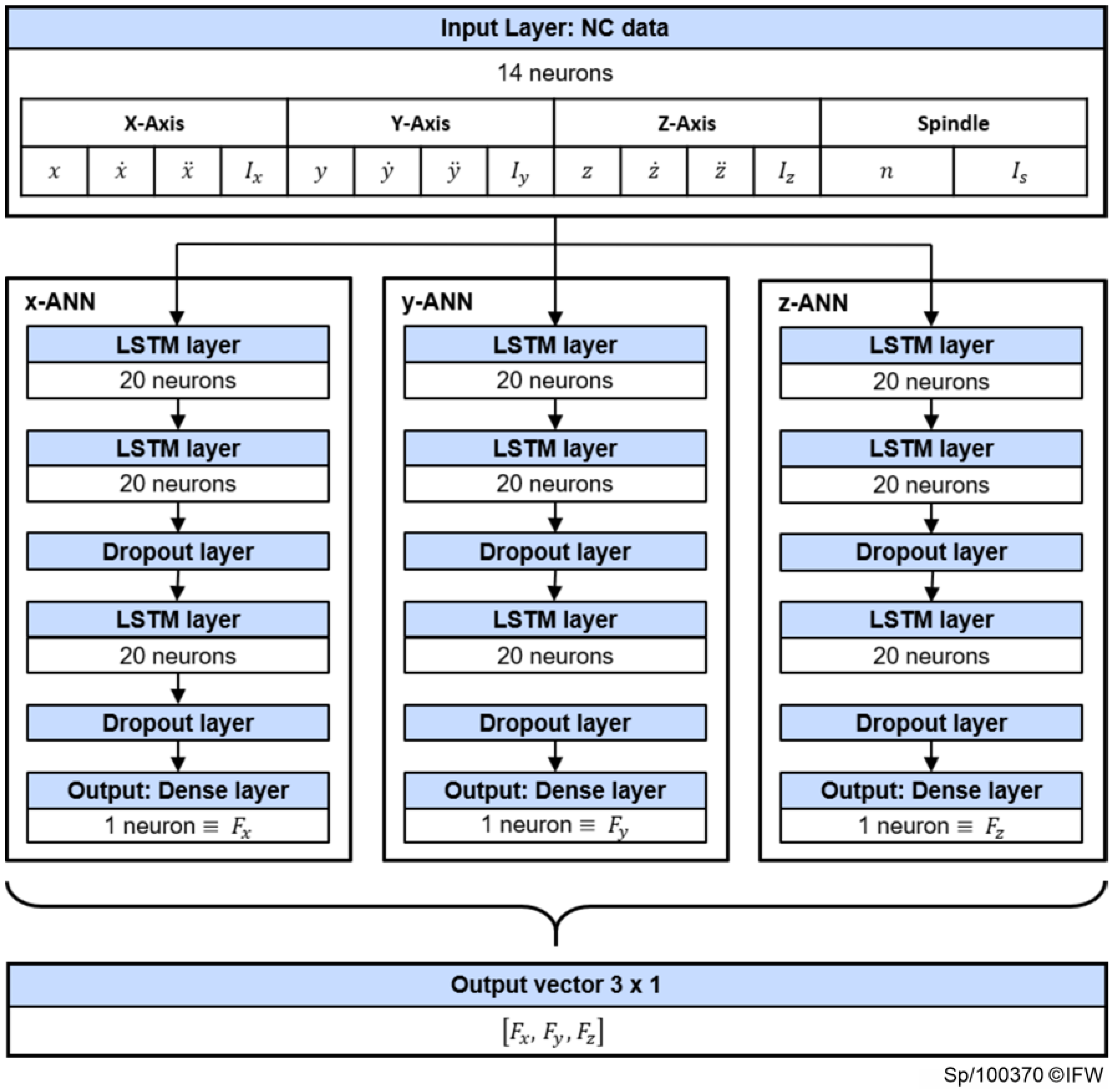
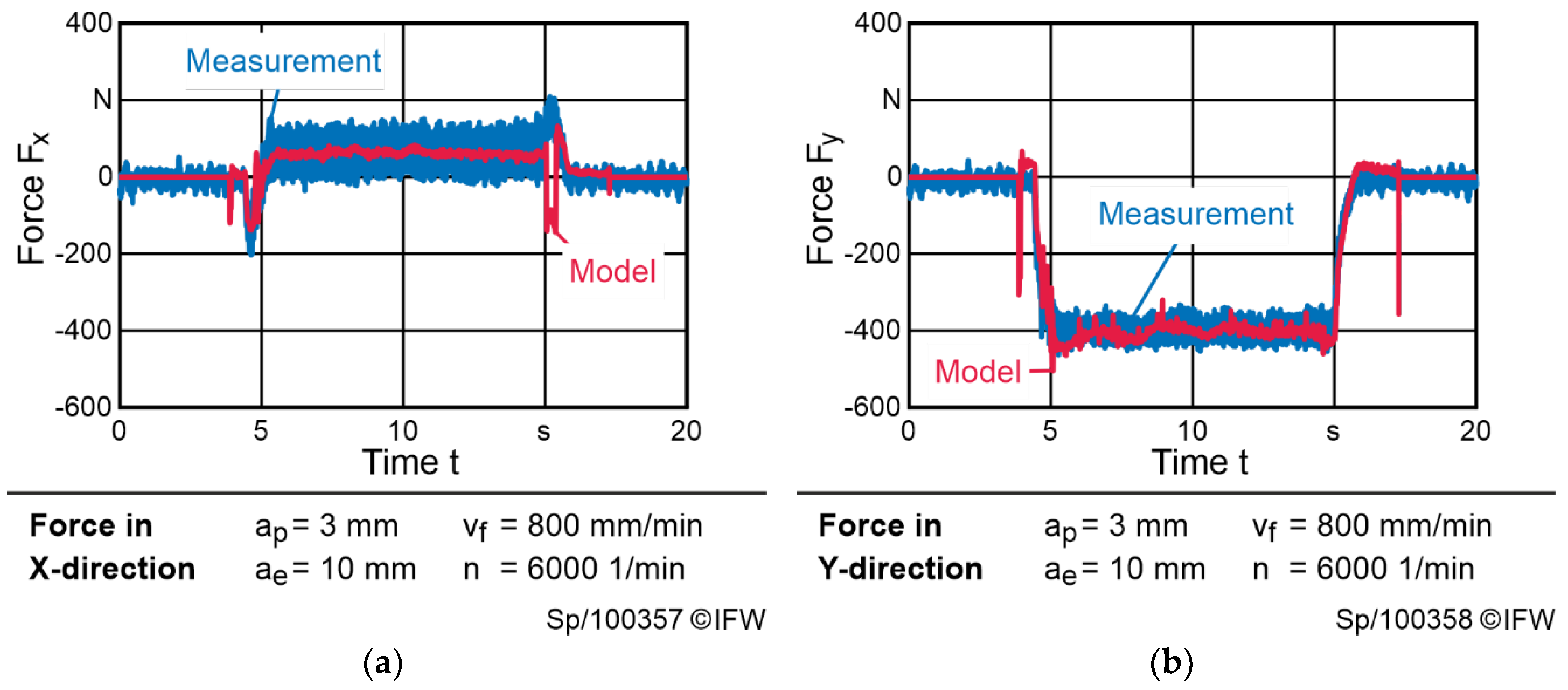
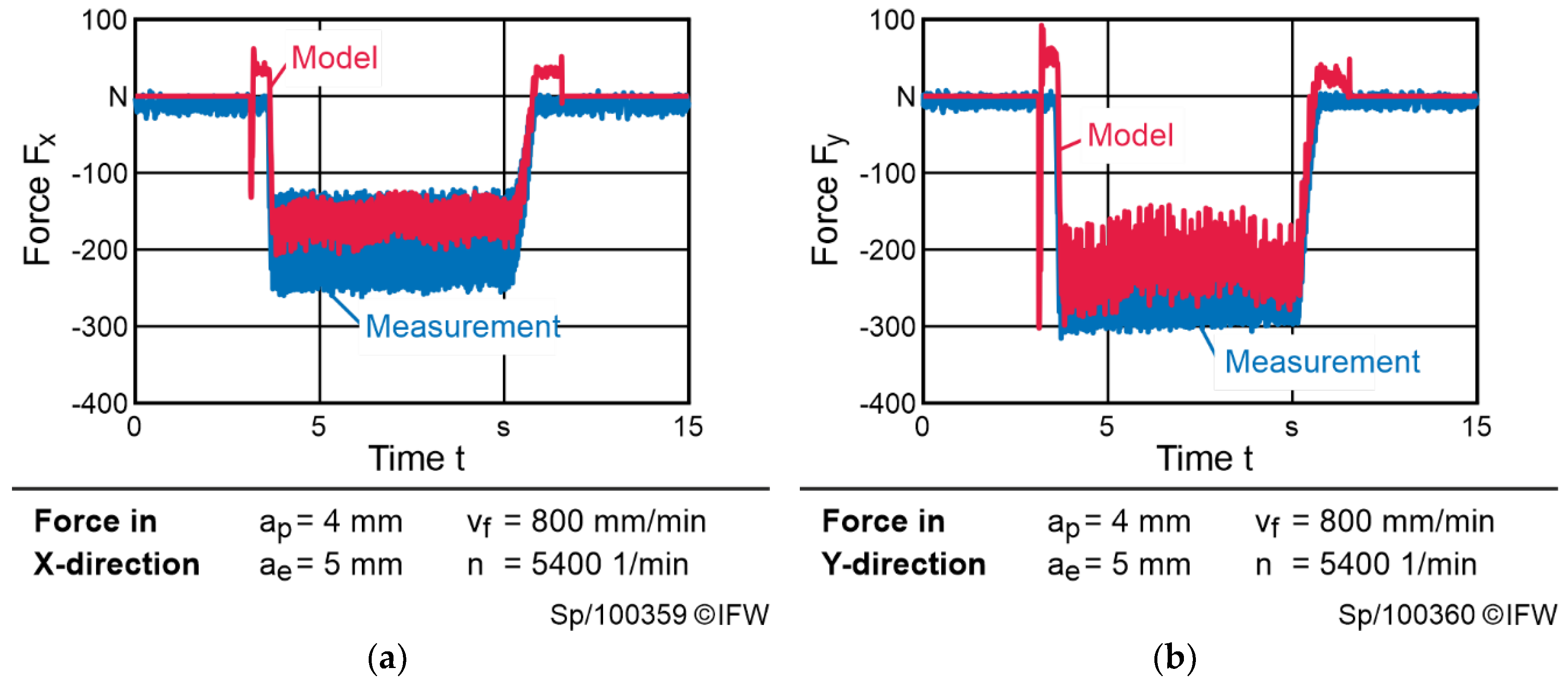
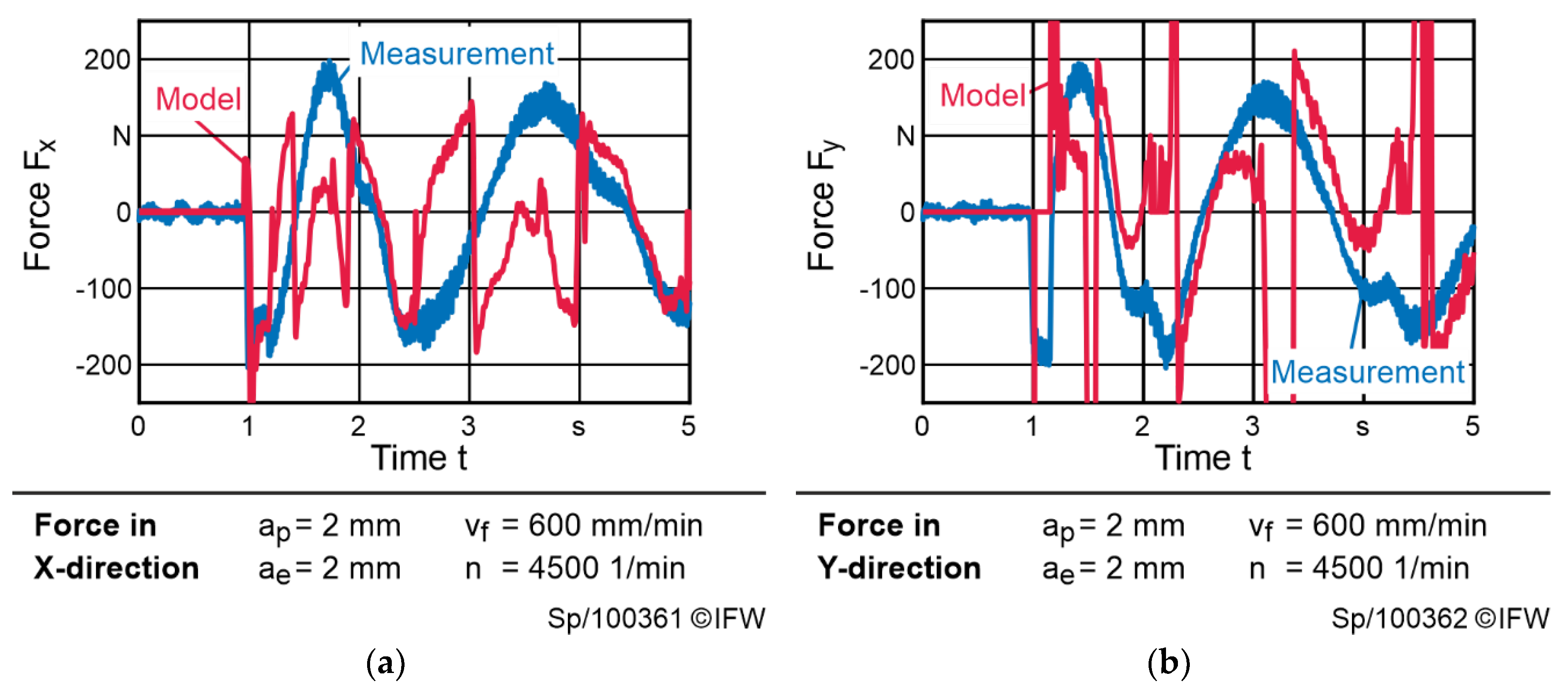
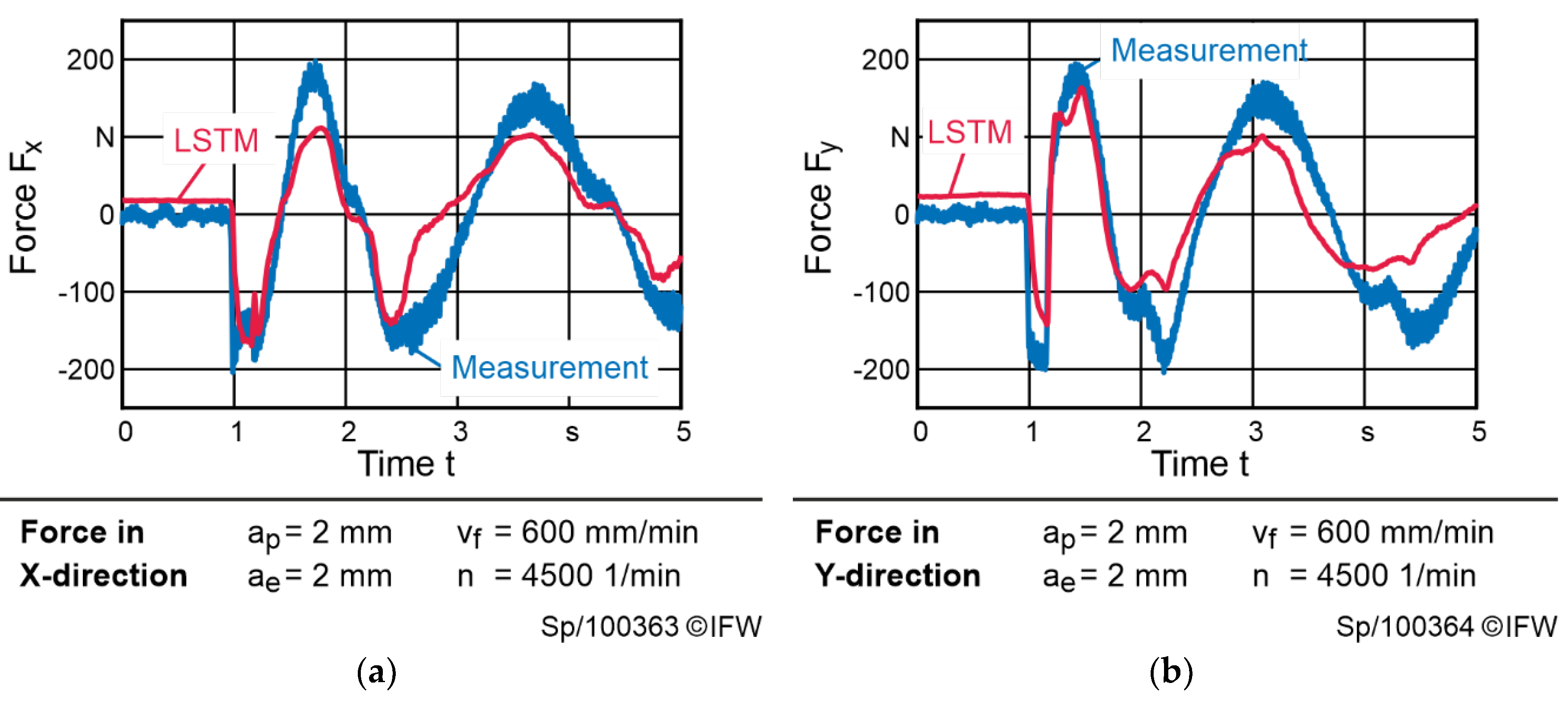


| Parameter | Unit | Variations |
|---|---|---|
| ap | (mm) | {1, 2, 3, 4} |
| ae | (mm) | {1, 2, 4, 5, 7, 10} |
| vf | (mm/min) | {300, 400, 500, 700, 800} |
| n | (1/min) | {2600, 3500, 4500, 5400, 6000} |
| Feed Direction | ae | ap | f | n | ANN | Model | Max. |Fme| |
|---|---|---|---|---|---|---|---|
| x|y | x|y | x|y | |||||
| (mm) | (mm) | (mm/min) | (1/min) | (N) | (N) | (N) | |
| +x | 5 | 2 | 800 | 5400 | 33.9|12.0 | 18.9|132.8 | 238.7|117.6 |
| +x | 5 | 2 | 800 | 6000 | 36.6|33.2 | 68.8|29.5 | 222.6|144.6 |
| +x | 5 | 5 | 800 | 5400 | 146.0|58.6 | 128.9|772.7 | 448.5|146.1 |
| +x | 7 | 2 | 400 | 2600 | 77.9|101.3 | 53.6|536.0 | 1016.7|740.5 |
| +x | 7 | 2 | 800 | 5400 | 36.8|29.2 | 31.5|225.1 | 372.6|208.3 |
| +x | 7 | 2 | 800 | 5400 | 33.8|25.4 | 30.1|127.0 | 241.1|166.8 |
| +x | 10 | 1 | 700 | 5000 | 35.6|54.8 | 23.3|129.4 | 375.0|317.8 |
| −x | 5 | 2 | 600 | 5400 | 30.1|22.6 | 45.0|51.5 | 80.8|212.3 |
| −x | 5 | 3 | 800 | 6000 | 42.7|27.7 | 32.8|30.3 | 100.4|320.9 |
| −x | 10 | 3 | 800 | 5000 | 34.3|19.5 | 12.9|26.8 | 268.5|536.9 |
| −y | 5 | 5 | 600 | 5400 | 48.7|88.6 | 99.0|245.3 | 478.8|281.5 |
| −y | 10 | 1 | 300 | 2600 | 48.5|74.1 | 157.4|179.0 | 579.6|634.4 |
| −y | 10 | 1 | 500 | 3500 | 42.5|81.1 | 90.5|172.4 | 836.0|709.6 |
| +x/−y | 5 | 2 | 600 | 4500 | 38.9|23.1 | 12.0|153.7 | 205.4|458.0 |
| +x/−y | 5 | 4 | 800 | 5400 | 36.9|31.1 | 30.7|33.5 | 261.3|314.25 |
| +x/−y | 10 | 1 | 600 | 5400 | 32.6|26.2 | 23.9|67.2 | 99.3|208.6 |
| −x/+y | 5 | 3 | 600 | 4500 | 68.6|26.6 | 157.1|26.3 | 324.9|544.3 |
| −x/+y | 5 | 4 | 800 | 6000 | 36.5|21.5 | 64.4|54.4 | 297.4|246.0 |
| −x/+y | 10 | 2 | 600 | 5400 | 35.0|32.1 | 47.7|163.4 | 156.6|321.5 |
| −y/+z | 10 | 0 to 2 | 600 | 5000 | 28.1|21.4 | 50.6|18.2 | 206.2|115.5 |
| ccw | 2 | 2 | 600 | 4500 | 49.8|38.3 | 104.4|149.1 | 247.5|437.0 |
© 2020 by the authors. Licensee MDPI, Basel, Switzerland. This article is an open access article distributed under the terms and conditions of the Creative Commons Attribution (CC BY) license (http://creativecommons.org/licenses/by/4.0/).
Share and Cite
Denkena, B.; Bergmann, B.; Stoppel, D. Reconstruction of Process Forces in a Five-Axis Milling Center with a LSTM Neural Network in Comparison to a Model-Based Approach. J. Manuf. Mater. Process. 2020, 4, 62. https://doi.org/10.3390/jmmp4030062
Denkena B, Bergmann B, Stoppel D. Reconstruction of Process Forces in a Five-Axis Milling Center with a LSTM Neural Network in Comparison to a Model-Based Approach. Journal of Manufacturing and Materials Processing. 2020; 4(3):62. https://doi.org/10.3390/jmmp4030062
Chicago/Turabian StyleDenkena, Berend, Benjamin Bergmann, and Dennis Stoppel. 2020. "Reconstruction of Process Forces in a Five-Axis Milling Center with a LSTM Neural Network in Comparison to a Model-Based Approach" Journal of Manufacturing and Materials Processing 4, no. 3: 62. https://doi.org/10.3390/jmmp4030062
APA StyleDenkena, B., Bergmann, B., & Stoppel, D. (2020). Reconstruction of Process Forces in a Five-Axis Milling Center with a LSTM Neural Network in Comparison to a Model-Based Approach. Journal of Manufacturing and Materials Processing, 4(3), 62. https://doi.org/10.3390/jmmp4030062




